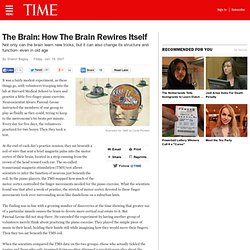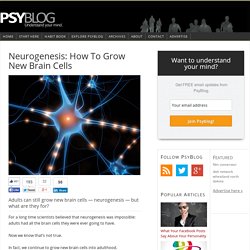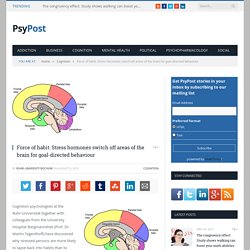

How The Brain Rewires Itself. It was a fairly modest experiment, as these things go, with volunteers trooping into the lab at Harvard Medical School to learn and practice a little five-finger piano exercise.

Neuroscientist Alvaro Pascual-Leone instructed the members of one group to play as fluidly as they could, trying to keep to the metronome's 60 beats per minute. Every day for five days, the volunteers practiced for two hours. Then they took a test. At the end of each day's practice session, they sat beneath a coil of wire that sent a brief magnetic pulse into the motor cortex of their brain, located in a strip running from the crown of the head toward each ear. The so-called transcranial-magnetic-stimulation (TMS) test allows scientists to infer the function of neurons just beneath the coil. Neurogenesis: How To Grow New Brain Cells. Adults can still grow new brain cells — neurogenesis — but what are they for?

For a long time scientists believed that neurogenesis was impossible: adults had all the brain cells they were ever going to have. Now we know that’s not true. In fact, we continue to grow new brain cells into adulthood. The race is on to find out what these brain cells are for and how we can grow more of them. A new review of the scientific literature, published in the journal Trends in Cognitive Sciences, argues that the growth of new cells aids adaptation to the environment (Opendak & Gould, 2015). Neuroplasticity. Brain Facts and Figures. 30 Amazing Facts About Your Brain. Get The New Ebook ’70 Amazing Facts About Your Brain’ now if you sign up for my newsletter you will get a PDF version of the book along with 3 other books on goal setting, motivational quotes and dealing with stress.

If you’d like a copy of the Kindle version, that is only available through Amazon here and it’s priced at a very affordable $2.99 Useful Self Development Brain Stuff 1. You have a finite amount of will power each day because to exercise will power you need energy in the form of oxygen and glucose That’s why it’s harder to say ‘no’ when you are tired or not feeling yourself. 2. 3. So make sure you don’t think, “Why do I suck?” 4. That’s why even left-brained people can have times of the day when they are more creative and right-brained people can sometimes get their taxes in order. Note: If you want to know how you can tell which side is dominant at any one time, check out Creativity – Guaranteed and you can then plan your time accordingly. 5. 6.
How Thinking Works: 10 Brilliant Cognitive Psychology Studies Everyone Should Know. How experts think, the power of framing, the miracle of attention, the weird world of cognitive biases and more… Fifty years ago there was a revolution in psychology which changed the way we think about the mind.

The ‘cognitive revolution’ inspired psychologists to start thinking of the mind as a kind of organic computer, rather than as an impenetrable black box which would never be understood. This metaphor has motivated psychologists to investigate the software central to our everyday functioning, opening the way to insights into how we think, reason, learn, remember and produce language. Here are 10 classic cognitive psychology studies that have helped reveal how thinking works. 1. How The Brain Processes The #Emotions — P... Personality Traits Correlate With Brain Activity. Your personality says a lot about you.

To categorize people by their disposition, psychologists have long relied on questionnaires. Now, however, researchers may be closing in on a tangible view of character in the brain. According to a recent study in PLoS One, resting brain activity varies with a person’s scores on a well-established personality test. When awake but not engaged in a task, each subject displayed activity patterns distinct from those found in someone with different traits. Even at rest, the brain hums with neural activity. Using functional MRI, the researchers monitored the resting state of 39 healthy participants and looked for regions that tended to activate together. Neural Mechanisms Linked With Vulnerability To Anxiety.
Force of habit: Stress hormones switch off areas of the brain for goal-directed behaviour. Cognition psychologists at the Ruhr-Universität together with colleagues from the University Hospital Bergmannsheil (Prof.

Dr. Martin Tegenthoff) have discovered why stressed persons are more likely to lapse back into habits than to behave goal-directed. The team of PD Dr. Lars Schwabe and Prof. Dr. Two stress hormones in use In order to test the different stress hormones, the cognition psychologists used three substances – a placebo, the stress hormone hydrocortisone and yohimbine, which ensures that the stress hormone noradrenaline stays active longer. Goal-directed behaviour and habits investigated in the experiment In the experiment, all participants – both male and female – learned that they would receive cocoa or orange juice as a reward if they chose certain symbols on the computer. Combined effect of yohimbine and hydrocortisone As expected, volunteers who took yohimbine and hydrocortisone did not behave goal-directed but according to habit.